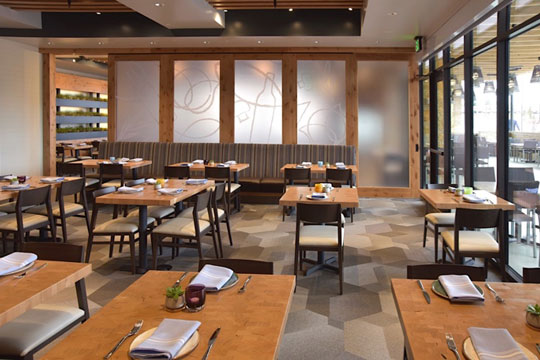Pan Asian Dining Islamabad: Relish Authentic Asian Recipes
Experience the Blend of Societies in Our Pan-Asian Dining establishment's Oriental Food Offerings
Each dish on our food selection is a thoroughly crafted narrative, attracting on the rich heritage of Chinese, Japanese, Thai, Korean, and Vietnamese cuisines. As you explore the intricacies of our offerings, you'll come across a harmony of tastes that mirrors the dynamic variety of these cultures.
Exploring Chinese Culinary Traditions
Chinese cooking practices boast an abundant tapestry of tastes and strategies that show the nation's huge geographic and multiculturalism. From the intense seasonings of Sichuan food to the delicate dim amount of Cantonese fare, each area presents an unique cooking identification that has actually been developed over centuries. The approach of stabilizing tastes-- pleasant, sour, bitter, spicy, and salty-- lies at the heart of Chinese food preparation, creating meals that are not just scrumptious but likewise harmonious.
Secret ingredients such as soy sauce, ginger, sesame, and garlic oil form the backbone of numerous traditional dishes, adding to the distinct and fragrant accounts that define Chinese cuisine. Methods like stir-frying, steaming, and braising demonstrate the ability and artistry associated with Chinese cooking, each method improving the all-natural flavors of the active ingredients.
Regional specializeds, such as Peking duck from Beijing, the subtle, savory flavors of Shanghai's soup dumplings, and the bold, extreme warm of Sichuan warm pot, use an insight into the cooking heritage of China. In a Pan-Asian restaurant setup, these traditional meals can be adjusted to integrate various influences, supplying customers a nuanced exploration of Chinese cooking virtuosity.
Appreciating Japanese Specials

Start your cooking journey with sashimi, where the freshness of the fish takes facility stage, chopped skillfully to enhance its all-natural taste. Our sushi supplies an unified blend of vinegared rice and fresh fish and shellfish, a tribute to the nuance of Japanese gastronomy. For a cozy, comforting experience, attempt our miso soup, a staple that symbolizes the umami-rich account of fermented soybeans.

Uncovering Thai Taste Profiles
As we relocate from the refined elegance of Japanese cuisine, the vibrant and dynamic tastes of Thai food preparation welcome expedition. Thai food is renowned for its harmonious balance of sweet, sour, salty, and spicy aspects, producing a symphony of preferences that captivate the palate. Trick ingredients like lemongrass, kaffir lime leaves, galangal, and Thai basil give aromatic intricacy, while fish sauce and shrimp paste give depth and umami.
One can not review Thai flavor profiles without discussing the iconic meals that exemplify its cooking approach. The celebrated Tom Yum soup, with its fragrant brew, combines spicy, sour, and mouthwatering notes, providing a preference experience that is both stimulating and comforting. pan asian restaurant Islamabad. Similarly, Green Curry, understood for its abundant coconut milk base, showcases the fragile interaction in between sweet taste and spiciness, improved by fresh natural herbs and spices
Thai cuisine additionally puts a solid emphasis on structure, blending crispy veggies with tender meats or seafood, as seen in dishes like Som Tum (green papaya salad) This equilibrium of appearances adds an extra layer of satisfaction to the already intricate taste profiles. Through these unique components, Thai food offers a extraordinary and vibrant culinary trip.
Enjoying Oriental Spice and Warmth
Korean food, with its focus on strong spices and intense warm, supplies a special exploration of tastes unique from its Asian equivalents. At the heart of this cooking experience is gochujang, a fermented red chili paste that provides a foundation of sweet warm and deepness. Chinese food Islamabad. This functional active ingredient is pivotal in meals such as bibimbap and bulgogi, instilling them with its particular spicy-sweet profile
An additional foundation of Oriental seasoning is kimchi, a fermented veggie recipe most frequently made from napa cabbage and seasoned with chili ginger, garlic, and pepper. Kimchi not only includes a piquant kick to any type of dish however likewise supplies probiotic advantages, making it a staple in Korean eating.
Additionally, Korean barbecue highlights the interplay of seasoning and heat via marinates that typically incorporate gochugaru, a crude chili powder. This enhances the flavors of smoked meats, developing a nuanced and rich taste experience.
Our Pan-Asian restaurant happily accepts these elements, offering diners an authentic taste of Korean warmth and spice. Each recipe is crafted to guarantee that the dynamic flavors and textures of Oriental cuisine shine through, providing a remarkable dining experience.
Tasting Vietnamese Quality
Vietnamese food is renowned for its exceptional freshness asian fusion restaurant and vivid, floral flavors, developing a distinctive cooking identity within Asia. At the heart of Vietnamese food preparation exists the viewpoint of balancing contrasting aspects-- wonderful, sour, salted, and spicy. This harmony is obvious in recipes like pho, an aromatic noodle soup that incorporates fragrant herbs such as cilantro and basil with the abundant deepness of a beef or poultry brew. The addition of lime and chili improves the intricacy, supplying a refreshing experience in every dose.
Quality is further exhibited in the iconic summertime rolls, called gỏi cuốn. These translucent rice paper rolls are loaded with crisp vegetables, fresh natural herbs, and tender shrimp or pork, come with by a mouthwatering peanut dipping sauce. The fragile yet robust flavors emphasize the importance Vietnamese food position on fresh ingredients.
Our Pan-Asian restaurant commemorates this cooking practice by sourcing the finest ingredients to recreate genuine Vietnamese dishes. The emphasis on natural herbs and fresh fruit and vegetables makes sure that each recipe is not only visually enticing but also a testimony to the vibrant society from which it comes from. Experience Vietnamese freshness with us, where every bite narrates of practice and flavor.
Final Thought
The Pan-Asian dining establishment supplies a distinct culinary experience by sympathetically blending the rich customs of Chinese, Japanese, Thai, Korean, and Vietnamese cuisines. Each dish is thoroughly crafted to highlight the distinctive methods and genuine active ingredients of these varied societies, producing a natural yet different gastronomic trip. With an emphasis on equilibrium, boldness, and freshness, the restaurant transcends social boundaries, offering diners with an excellent combination of tastes that commemorates the essence of Asian cooking heritage.
While Japanese food is renowned for its simpleness and beauty, it also uses a depth of flavor achieved with careful preparation and a regard for seasonal components.As we relocate from the fine-tuned elegance of Japanese cuisine, the vibrant and bold flavors of Thai food preparation welcome expedition.One can not discuss Thai flavor profiles without discussing the famous meals that exemplify its cooking ideology.Oriental cuisine, with its focus on strong seasonings and fiery warmth, supplies a special exploration of tastes distinctive from its Eastern counterparts.Vietnamese cuisine is renowned for its remarkable freshness and vivid, herbaceous tastes, creating a distinct culinary identity within Asia.